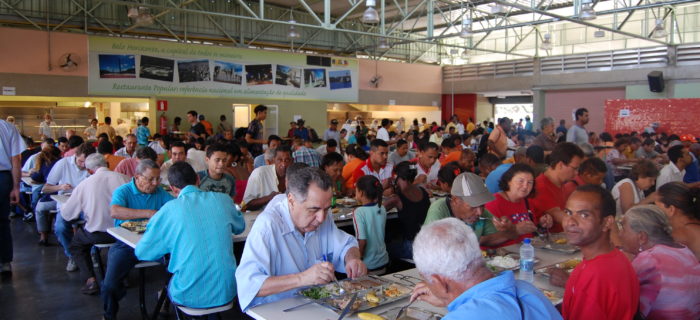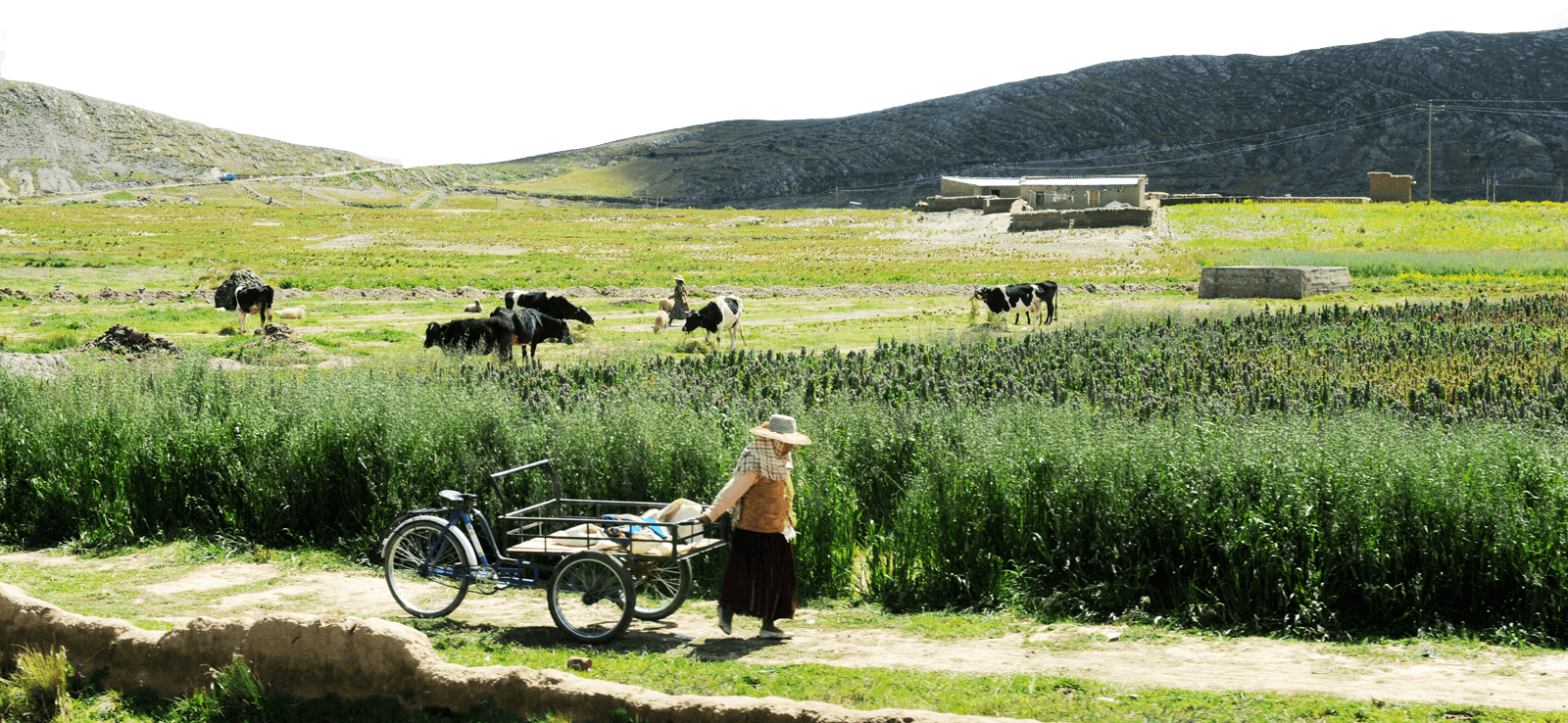Continuing on the Road to Ending Hunger
Click here to Download this Backgrounder.
Frances Moore Lappé’s 1972 book Diet for a Small Planet astonished the world by revealing why hunger truly exists. It isn’t overpopulation or the underproduction of food. Instead, Lappé writes, it is “the issue of power – who is making the decisions” that needs to be faced if we are to “get at the roots of needless hunger.” Food First continues this decades-long fight in Eric Holt-Giménez’s 2019 book Can We Feed the World Without Destroying It? According to Holt-Giménez, we must build powerful social movements to address inequities of power at their roots.
Food First’s incoming Executive Director, M. Jahi Chappell, builds on this notion by examining how decades of movement organizing paired with local government programming led to the beginnings of an end to hunger in Belo Horizonte, Brazil. The following Backgrounder is an abridged and edited portion of Chappell’s book Beginning to End Hunger. It offers important lessons on the persistence and adaptability of social movements on the long but necessary road to justice.
Are the Tools to End Hunger Already Here?
Author William Gibson famously said that the future is already here, it’s just not very evenly distributed. But this future is not based on the promises of advanced technology. Rather, it is seen in the more mundane features of our lives: the social and political institutions underlying how we make decisions about what we will do, how to do it, and how we distribute the power and resources that make life possible. These “institutions” (societal rules and patterns) are about how we run our lives and the conscious and unconscious mechanics underneath the surface.
It is within our reach to end hunger in the world. It has been within our reach for a while now.
Important “innovations” in institutions, such as the concepts of human rights, public education, or gender equality, have never been instantly and evenly distributed everywhere. All institutions started as an idea among a smaller number of people before they went on to influence and shape the lives of billions. So it is with hunger, where the future institutions we need are in many ways already here, even if we don’t yet see them everywhere.
Imagining New Possibilities, Pursuing Better Futures
It is within our reach to end hunger in the world. It has been within our reach for a while now. But the challenges we must surmount to achieve this have been fundamentally, essentially institutional. We have not designed our societies to accomplish food security or end hunger. In fact, we (through our nations and international organizations), have chosen to give higher priority to other objectives, whether this be trade and the freedoms of multinational corporations, notions of “progress” that minimize the role of agriculture, or adherence to certain convictions about the role of government and community versus the private sector. We now have international philanthrocapitalism (think Bill Gates or Richard Branson) in place of accountable international institutions with the capacity to challenge inequality. We have embraced charity covering the damage of the status quo over changes of discernible impact. Yet few of us have directly had a say in these choices. Too often we have accepted institutions changing for the worse, or not changing at all, out of reluctance, detachment, or a feeling of impotence. And it is certain that the majority of the planet’s people—most of them in the so-called Global South—have not been consulted as equal partners.
Yet there is no reason we cannot imagine and pursue alternative possibilities and better futures. Any new institution often appears impossible, until seemingly suddenly, there they are. Think of the end of the South African Apartheid, the end of U.S. slavery, the rise of democracy, the end of many monarchies and colonial empires, the right to vote for women and minorities, and the institution of universal health care in many of the world’s countries. All of these have been important steps of institutional change, rooted in social pressure and struggle, and resulting in changes in attitude, culture and institutions. Yet significant turning points like these represent only middle points in continuing changes in our institutions, towards a future we cannot yet see, but have the power to make better for all.
Stay in the loop with Food First!
Get our independent analysis, research, and other publications you care about to your inbox for free!
Sign up today!This is not mere optimism or faith, but hope paired with evidence. We see thousands, even millions, of innovations in institutions around the world. We have seen countries such as Brazil achieving notable successes and dramatic steps forward, albeit inevitably incomplete and, without continuing activity by citizens, possibly impermanent.
Lessons from Belo Horizonte
The case of Belo Horizonte (BH), the Brazilian city that is at the forefront of food security innovations and the focus of this book, does not “prove” that we can get to the end of world hunger. But its very real successes do allow us to rethink and gauge new possibilities about the alternative futures that we can build.
BH has been home to one of the world’s most successful food security programs since 1993. At the time that this book was published, infant malnutrition and mortality in BH had been cut by more than 50 percent. Fruit and vegetable consumption had increased considerably.1 Infant mortality had fallen by more than 70 percent. And there was a 33 percent decrease in hospitalization due to diabetes.2
The institutions built up in Belo Horizonte and Brazil were the inheritors and successors of accumulated efforts, experiences, and analyses developed over decades.
An estimated 800,000 citizens interact each year with Belo Horizonte’s programs — almost 40 percent of the population in 2003.3 BH’s comprehensive approach improved the food security of high-risk populations and increased food access city-wide. BH also used city programs to support local agriculture and improve family farmers’ livelihoods. In the process, Belo Horizonte has invented and re-invented many food security institutions and helped spur Brazil’s larger national program, Fome Zero (Zero Hunger), which has been recognized across the globe for its accomplishments.4 BH redefined national and international standards for institutions governing the right to food.
The institutions built up in Belo Horizonte and Brazil were the inheritors and successors of accumulated efforts, experiences, and analyses developed over decades. A partial genealogy would include Brazilian geographer Josué de Castro’s revolutionary work on hunger in the 1930s; the implementation and then dismantling of the Brazilian Social Security Food Service in the 1940s; Brazil’s tide of post-1970s social movements; the National Constitutional Assemblies of 1986 – 1988; the thousands of local committees of the Citizens’ Action Against Hunger and Poverty and for Life; the hundreds of state-civil society-business citizens’ councils implemented out of the 1988 Constitution’s consultative requirements; the formation, dissolution, and reinstitution of regional and national food security councils; and finally Belo Horizonte’s program, the Municipal Office of Food and Nutritional Security (SMASAN), which was followed by the creation of Fome Zero in 2004, the passage of a national law declaring a right to food in 2006; and the Constitutional Right to Food in 2010.
What Belo Horizonte Means for Brazil—and the Rest of Us!—Moving Forward
The scale and depth of BH and Fome Zero’s advancements in fighting hunger offer us a chance to envision dramatic transformations for the better elsewhere. Although there is no simple formula that would allow us to recreate these successes anew in another context, they can provide us insights on how to move farther down the path to the end of hunger.
We must always remember that no movement knew it was going to be successful when it took on its work. What the most successful movements knew, however, was that they would not stop in their work towards a better society for all.
This is true even despite the regressive policies and cuts to social programs by Brazil’s current and previous right-wing presidents. We must remember that progress in every social struggle, including the battle against hunger in Brazil, will always see setbacks. For example, we might think of the United States, where there have been centuries of ebb and flow in social pressure for change, alternative visions offered by activists, scholars, and revolutionaries, and the social leaders responding to pressure that led to progress in areas from abolition, to suffrage, to civil rights, to the recent, embattled healthcare Affordable Care Act—which may yet give way to even more ambitious and equitable programs. In all of these cases, it took a complex array of political and social conditions along with particular circumstances for radical individuals and social movements to succeed in creating social change together. We must always remember that no movement knew it was going to be successful when it took on its work. What the most successful movements knew, however, was that they would not stop in their work towards a better society for all.
I propose that if the U.S. food movement and those seeking to support food sovereignty viewed the challenges before us in this light, we might choose to invest more in preparing and creating the circumstances for change. That is, invest in building not just a “movement,” but a movement ecosystem, where reciprocity and trust pervade rather than (ir)rationales of scarcity. The more we work in and across our own communities and networks to build up many different empowered potential leaders ready for change, the more likely it is that change will come. We have to work past what Rev. William Barber, II has called the “one moment” mentality, and a focus on finding a few charismatic leaders at “the top.” Rather, we have to build capacity within our communities such that many people have the resources and support to try different strategies for change, repeatedly. The more we have many potential leaders, from all walks of life, trying and practicing new tactics, the more ready we will be when the circumstances for dramatic change truly come.
Like all aspects of the future, the institutions for food sovereignty and food security are not evenly distributed. They’re not always even easily apparent. But they are there.
With this lens, we can see that the institutions we need to end hunger are, even now, in practice in some places. We have countless examples of communities that are making new paths by walking them. By developing approaches rooted in a full appreciation of human rights, in substantive democracy and citizenship, we can foster large-scale transformations that respect and amplify local communities’ food sovereignty and agency. We can build out the “futuristic” institutions that will end hunger. Take your pick of your favorite institution—human rights, public education, democracy, egalitarianism, marriage equality, gender equality, racial equality, food security, food justice, food sovereignty—each started small, but now influence and shape billions of the world’s people: their behavior, expectations, and dreams.
Like all aspects of the future, the institutions for food sovereignty and food security are not evenly distributed. They’re not always even easily apparent. But they are there. When we look around carefully, not with “silly optimism” but rather “active optimism,” we can see spaces and communities we can ally with to do this important work: in the village councils of indigenous groups, in human rights’ groups, among new politicians and old ones, in an urban community of gardeners, in a network of Black food security thinkers, in the coordination of a growing international movement—the “new institutions” we need to overcome the great problems of the day may already exist. Whether one looks in Belo Horizonte, Brazil, or in the “backyard” of our own communities, an active optimism allows us to see the “good-news stories, pockets of reality that could be seeds of a wider vision.”5 The future, unevenly distributed as it may be, is also firmly present, whether it be in organizations such as Growing Gardens (Portland), Soul Fire Farm, La Vía Campesina, or the beats and flow laid down by the youth of North Minneapolis’ Appetite for Change. People are showing their commitment to a new world and new ways for new futures. We must see these initial steps along the path not as isolated efforts, but as multiple manifestations of a world where broader visions are already becoming reality.
It is down to all of us to end hunger. The work will be extremely difficult, but as so much evidence now shows us, if we work together, ending hunger is possible.
Cover image: One of Belo Horizonte’s publicly-owned, Popular restaurants providing affordable, healthy food to the public. Photo courtesy of Cecilia Rocha.
Click here to download this Backgrounder.
- IBGE (Instituto Brasileiro de Geogfrafia e Estatítica). 2010. “Aquisicao Alimentar Domiciliar per capita Brasil e Grandes Regioes: Tabelas
Completas: Municipios.” Pesquisa de Orcamentos Familiares 2008-2009. Retrieved from (http://www.ibge.gov.br/home/estatistica/populacao/ condicaodevida/pof/2008_2009_aquisicao/default_zip.shtm) - PMBH (Prefeitura de Municipal Belo Horizonte). 2016. “Estatísticas e Indicadores: Saúde.” Retrieved from https://archive.foodfirst.org/statistics-forbelo-horizonte-fall-2019-food-first-backgrounder/
- Aranha, A. V. 2003. “Food Security, Public Management and Citizenship: The Experience of Belo Horizonte , Brazil – 1993/2003.” Paper presented at the Conference on Community Food Security, Reyerson University, Toronto, Canada, July 2003.
- Although the present authoritarian, right-wing president of Brazil, Jair Bolsonaro, has dismantled much of Fome Zero’s programs, that has not stopped its example from inspiring new approaches and renewed efforts against hunger across the globe. Additionally, a key point we can learn from BH is that what has been learned and built can be improved on, and built again.
- Meadows, D. 1996. “Envisioning a Sustainable World.” In Getting Down to Earth: Practical Applications of Ecological Economics, edited by R. Costanza, O. Segura, and J. Martinez-Alier, 117-26. Washington, DC




 Help Food First to continue growing an informed, transformative, and flourishing food movement.
Help Food First to continue growing an informed, transformative, and flourishing food movement.




